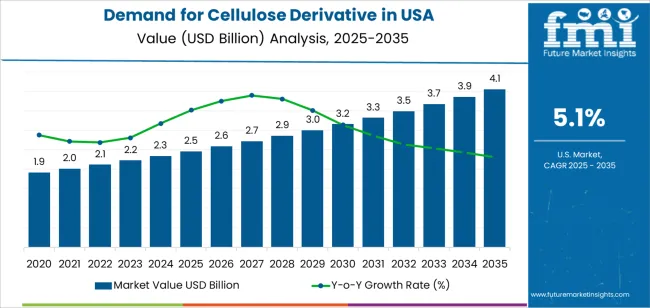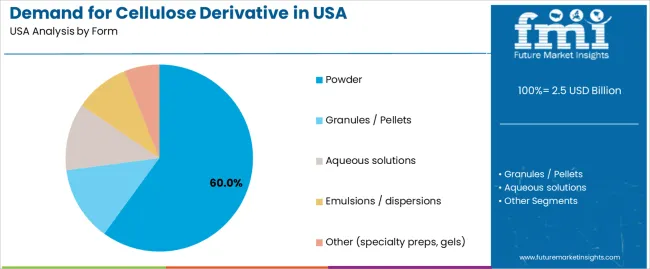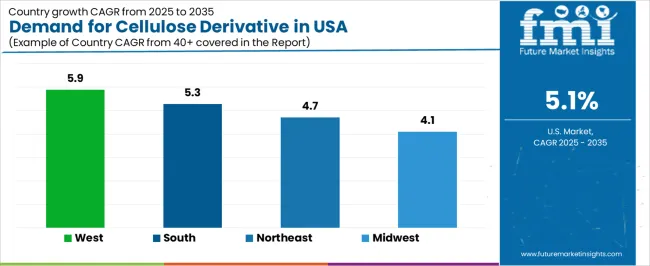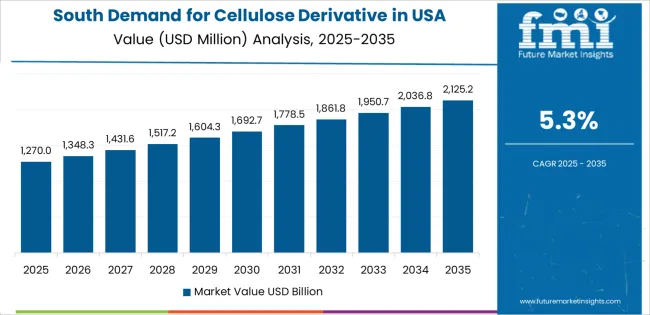The demand for cellulose derivatives in the USA is projected to increase from USD 2.5 billion in 2025 to USD 4.1 billion by 2035, reflecting a CAGR of 5.1%. Cellulose derivatives, including ethyl cellulose, methyl cellulose, and carboxymethyl cellulose, are used across a variety of industries such as pharmaceuticals, food processing, cosmetics, and paper manufacturing. The growth in this segment is driven by the increasing demand for biodegradable products, the expansion of the pharmaceutical industry, and the growing focus on sustainability and eco-friendly packaging solutions. As natural-based products continue to gain favor over synthetic materials, cellulose derivatives, which are derived from wood pulp or cotton, play an important role in providing more sustainable alternatives.
The market will also benefit from innovations in cellulose derivative applications, particularly in the food, personal care, and construction industries. The rise in health-conscious consumer behavior and the increasing focus on environmental impact will continue to push the adoption of cellulose derivatives. The growth of biotechnology and green chemistry will also contribute to the ongoing development of new cellulose-based materials, further increasing the segment’s overall demand.

The Growth Rate Volatility Index (GRVI) for cellulose derivatives in the USA reflects moderate growth fluctuations over the forecast period, with stable periods of acceleration followed by periods of more consistent growth. The market, expected to grow from USD 2.5 billion in 2025 to USD 4.1 billion in 2035, will experience relatively smooth growth, but there will be notable volatility depending on key industry developments.
From 2025 to 2030, the market will grow from USD 2.5 billion to USD 3.2 billion, with the first few years experiencing steady growth. The initial volatility will occur as demand for cellulose derivatives rises due to increasing investments in the pharmaceutical and food sectors, alongside the adoption of biodegradable alternatives to plastics. During this period, some volatility could occur due to the shift in regulatory environments and changes in raw material availability that may slightly impact pricing and production.
From 2030 to 2035, the market will expand from USD 3.2 billion to USD 4.1 billion, adding USD 0.9 billion in value. This phase will likely see moderate growth, with reduced volatility as cellulose derivatives become more entrenched in mainstream applications. While growth will remain steady, advancements in biotechnology and environmentally-friendly product innovations will drive more gradual increases in demand. The stability of the segment in the later years reflects the maturity of its applications and widespread adoption across industries focused on sustainability and eco-friendly practices. Thus, while the early years may experience some market fluctuations, the overall trend will be relatively stable and characterized by moderate growth in the latter half of the forecast period.
| Metric | Value |
|---|---|
| Sales Value (2025) | USD 74.1 million |
| Forecast Value (2035) | USD 106.7 million |
| Forecast CAGR (2025-2035) | 3.5% |
Demand for cellulose derivatives in the USA is increasing as industries shift toward performance materials that are renewable, functional, and sustainable. These derivatives, such as methyl cellulose, hydroxypropyl cellulose, and carboxymethyl cellulose, are used across sectors including pharmaceuticals, food and beverage, personal care, construction, and paper. In pharmaceutical manufacturing they serve as excipients, binders or film formers; in foods they act as thickeners, stabilizers or fat replacers; in construction they aid in mortars and plasters; and in papers and non wovens they support structure and durability. The growing preference among manufacturers and brands for bio based and clean label materials supports uptake of cellulose derivatives in the USA.
Another factor boosting demand is technological advancement and regulatory emphasis on quality, performance and sustainability. Innovations in cellulose derivative chemistry allow improved functionality (for example better film forming, higher purity or tailored dissolution rates) which appeal to R&D driven end users in the USA. At the same time, regulatory frameworks in food and pharmaceuticals favour materials with well established safety profiles and renewable sourcing. Challenges remain in the form of production cost pressures, competition from synthetic alternatives, and supply chain complexities for specialty grades. Despite these headwinds, the convergence of sustainability goals, functional formulation demands and regulatory best practice supports steady growth of cellulose derivative demand in the USA.
The demand for cellulose derivatives in the USA is segmented by form and end use. The leading form is powder, which holds 60% of the market share, while the dominant end-use sector is the pharmaceutical industry, accounting for 30% of the market. Cellulose derivatives, such as cellulose ethers and esters, play a crucial role in various industries due to their ability to modify the properties of products, including improving viscosity, stability, and solubility. The growing demand for high-quality and functional ingredients in the pharmaceutical, food, and personal care sectors continues to drive the market for cellulose derivatives in the USA.

The powder form of cellulose derivatives leads the market, capturing 60% of the demand in the USA. Powdered cellulose derivatives, such as hydroxypropyl methylcellulose (HPMC) and carboxymethyl cellulose (CMC), are highly versatile and are commonly used as binders, thickeners, and stabilizers in various applications. Their ability to dissolve easily in solvents and their ease of handling make them ideal for use in industries such as pharmaceuticals, food, and personal care.
In the pharmaceutical industry, powdered cellulose derivatives are widely used as excipients in tablet formulations, where they help in binding, disintegrating, and controlling the release of active ingredients. In the food industry, they are used to enhance texture, stabilize emulsions, and improve the shelf life of products. As the demand for functional ingredients grows, especially in the pharmaceutical sector, the powdered form of cellulose derivatives is expected to maintain its dominance due to its versatility and essential role in a wide range of applications.

The pharmaceutical industry is the largest end-user of cellulose derivatives in the USA, accounting for 30% of the market share. Cellulose derivatives play an essential role in pharmaceutical formulations due to their ability to modify the properties of drugs, including enhancing solubility, controlling release rates, and improving tablet cohesion. They are commonly used as excipients in oral solid dosage forms, such as tablets and capsules, where they serve functions like binders, disintegrants, and stabilizers.
The pharmaceutical industry’s reliance on cellulose derivatives continues to grow as the demand for new and more effective drug formulations increases. Cellulose derivatives are also used in controlled-release formulations, where they help regulate the release of active pharmaceutical ingredients over extended periods. As the pharmaceutical industry focuses on developing better drug delivery systems and improving the efficacy of treatments, the demand for cellulose derivatives will remain strong, ensuring their continued leadership in the market.
Demand for cellulose derivatives in the USA is supported by their wide ranging functionality across industries such as pharmaceuticals, food & beverage, construction, personal care and specialty chemicals. These derivatives—such as methylcellulose, ethyl cellulose and hydroxypropyl cellulose—provide thickening, stabilising, film forming and binding properties. Their renewable, bio based origin aligns with sustainability priorities, and mature industries in the USA favour high purity, performance grade materials. At the same time, raw material sourcing, regulatory quality standards and competition from alternatives influence adoption.
What Are The Primary Growth Drivers For Cellulose Derivative Demand in the United States?
Several drivers are advancing demand. First, the USA pharmaceutical industry’s need for high quality excipients such as cellulose ethers in tablets and coatings drives uptake. Second, accelerated construction activity and renovation projects increase use of cellulose derivatives in mortars, tile adhesives and plasters as rheology and water retention modifiers. Third, growth in clean label foods, personal care products and eco friendly packaging supports use of cellulose derivatives as natural, plant based functional materials. Finally, sustainability and circular economy trends promote use of bio based polymers, which benefits cellulose derivatives over purely synthetic alternatives.
What Are The Key Restraints Affecting Cellulose Derivative Demand in the United States?
Despite positive fundamentals, several constraints persist. The cost of higher performance, specialty cellulose derivatives can be significantly above generic alternatives, limiting adoption in cost sensitive applications. Supply chain challenges—such as raw cellulosic feedstock availability, logistic costs and manufacturing complexity—can affect pricing and reliability of supply. Moreover, competition from synthetic polymers and other bio polymers that may offer similar functionality at lower cost or with established supply chains poses a substitution risk. Finally, stringent regulatory quality demands—especially in pharmaceutical and food applications—require high purity grades, which may limit rapid scaling in newer applications.
What Are The Key Trends Shaping Cellulose Derivative Demand in the United States?
Notable trends include rising development of ultra high performance cellulose derivatives with tailored pore structure or film forming characteristics for advanced pharmaceutical and coating applications. There is growing interest in sustainable and circular feedstocks, including recycled cellulose and fermentation derived cellulose, which enhance environmental credentials. In food and personal care, clean label formulations are increasingly using cellulose derivatives as natural stabilisers and thickeners. Furthermore, integration of cellulose derivatives into advanced packaging solutions and biodegradable materials is expanding. Lastly, USA producers and users are leveraging digital manufacturing and real time quality monitoring to ensure consistency of performance in high specification applications.
The demand for cellulose derivatives in the USA is driven by their wide range of applications across industries like food and beverages, pharmaceuticals, cosmetics, paper and textiles, and construction. Cellulose derivatives, such as cellulose acetate, methylcellulose, hydroxypropyl cellulose, and carboxymethyl cellulose, are used for their binding, thickening, and gelling properties, which make them essential in many consumer and industrial products. The growing consumer preference for natural, biodegradable, and sustainable ingredients further boosts the demand for cellulose derivatives. Regional demand varies depending on industrial activities, manufacturing bases, and the adoption of eco-friendly materials. The West and South regions lead in demand due to strong industries in chemicals, pharmaceuticals, and food production, while the Northeast and Midwest follow with steady growth, supported by their established manufacturing sectors and research activities. This analysis examines the factors shaping the demand for cellulose derivatives across the USA.

| Region | CAGR (2025-2035) |
|---|---|
| West | 5.9% |
| South | 5.3% |
| Northeast | 4.7% |
| Midwest | 4.1% |
The West region leads the USA cellulose derivatives market with a CAGR of 5.9%. The West is home to a diverse range of industries, including pharmaceuticals, food and beverages, cosmetics, and construction, all of which drive demand for cellulose derivatives. The region’s focus on eco-friendly and sustainable materials is contributing to the growing preference for cellulose derivatives, which are biodegradable and non-toxic.
California, in particular, has a large consumer base that demands natural and organic products, leading to higher use of cellulose derivatives in food, personal care, and pharmaceutical applications. The region’s innovation-driven sectors, including biotechnology and pharmaceuticals, are also adopting cellulose derivatives for use in controlled-release formulations, wound care, and drug delivery systems. As sustainability trends continue to shape consumer behavior and industrial practices, the West remains the leading region for the demand for cellulose derivatives.

The South region shows strong growth with a CAGR of 5.3%. The region is a major hub for the food and beverage industry, which accounts for a significant portion of cellulose derivative demand. The increasing use of cellulose derivatives in food as thickeners, stabilizers, and gelling agents is driving market growth in the South. Additionally, the growing pharmaceutical and personal care sectors in states like Texas and Florida contribute to steady demand.
The South's strong agricultural base also supports the use of cellulose derivatives in the production of biodegradable products and eco-friendly packaging materials. As sustainability becomes a greater priority for manufacturers in the region, demand for cellulose derivatives as natural, sustainable, and non-toxic ingredients will continue to grow. Furthermore, the South’s expanding chemical manufacturing sector plays a role in boosting the production and availability of cellulose derivatives.
The Northeast region demonstrates a steady CAGR of 4.7%. The region has a well-established manufacturing base in pharmaceuticals, personal care, and food products, all of which rely on cellulose derivatives for a variety of applications. The demand for cellulose derivatives in the pharmaceutical industry, particularly for controlled-release drug formulations and excipients, is significant in the Northeast due to the region's concentration of pharmaceutical companies and research institutions.
The growing awareness of sustainable and natural products also supports demand in the personal care and cosmetics industries, where cellulose derivatives are used as emulsifiers, stabilizers, and gelling agents. With a focus on eco-conscious consumer preferences and increasing investment in green technologies, the Northeast will continue to see steady demand for cellulose derivatives across its manufacturing sectors.
The Midwest region shows a moderate CAGR of 4.1%. The Midwest is a key player in the food processing, paper, and textile industries, which are major consumers of cellulose derivatives. The use of cellulose derivatives as food thickeners, stabilizers, and binders, along with their role in paper coatings and textile treatments, contributes to steady demand in the region.
The Midwest’s manufacturing and agricultural sectors also rely on cellulose derivatives for a variety of applications, including the production of biodegradable products and construction materials. While the demand for cellulose derivatives in the Midwest is not growing as quickly as in other regions, the region’s solid industrial base and emphasis on sustainable products ensure consistent, long-term demand.

Demand for cellulose derivatives in the United States continues to grow, driven by their applications in industries such as pharmaceuticals, food and beverages, personal care, and industrial products. Companies like Dow Chemical Company (holding about 28.2% share), Ashland Global Holdings Inc., Rayonier Advanced Materials Inc., CP Kelco, and Celanese Corporation dominate the market. Cellulose derivatives such as carboxymethyl cellulose (CMC), hydroxyethyl cellulose (HEC), and methyl cellulose are used for their thickening, binding, and stabilizing properties, making them vital in the production of consumer goods like food, cosmetics, medicines, and coatings.
The competition in this market is primarily driven by the quality of cellulose derivatives, customization options, and application-specific innovations. One strategy focuses on enhancing product performance, such as improving viscosity control, stability under various conditions, and faster dissolution rates for pharmaceutical and food applications. Another strategic approach involves sustainability, with companies emphasizing their ability to source raw materials from sustainable sources and develop biodegradable cellulose derivatives for environmentally conscious industries. Firms are also investing in innovations for high-performance cellulose derivatives in emerging applications, such as drug delivery systems and green technologies. Marketing materials typically highlight product features like solubility, gelling properties, and compliance with regulatory standards. By aligning their product offerings with the growing demand for sustainable and high-performance ingredients across industries, these companies aim to strengthen their presence in the cellulose derivative market in the USA.
| Items | Details |
|---|---|
| Quantitative Units | USD Billion |
| Regions Covered | North America |
| Form | Powder, Granules / Pellets, Aqueous solutions, Emulsions / dispersions, Other (specialty preps, gels) |
| End Use | Pharmaceutical Industry, Food Industry, Personal Care, Construction, Paint Industry, Others |
| Key Companies Profiled | Dow Chemical Company, Ashland Global Holdings Inc., Rayonier Advanced Materials Inc., CP Kelco, Celanese Corporation |
| Additional Attributes | The market analysis includes dollar sales by form and end-use categories. It also covers regional demand trends in the United States, driven by applications in pharmaceuticals, food, personal care, and other industries. The competitive landscape highlights leading manufacturers focusing on innovations in cellulose derivative formulations for diverse sectors. Trends in the growing demand for eco-friendly and multifunctional ingredients in consumer goods and industrial applications are explored, along with advancements in cellulose-based materials and technologies. |
The global demand for cellulose derivative in USA is estimated to be valued at USD 2.5 billion in 2025.
The market size for the demand for cellulose derivative in USA is projected to reach USD 4.1 billion by 2035.
The demand for cellulose derivative in USA is expected to grow at a 5.1% CAGR between 2025 and 2035.
The key product types in demand for cellulose derivative in USA are powder, granules / pellets, aqueous solutions, emulsions / dispersions and other (specialty preps, gels).
In terms of end use, pharmaceutical industry segment to command 30.0% share in the demand for cellulose derivative in USA in 2025.






Our Research Products

The "Full Research Suite" delivers actionable market intel, deep dives on markets or technologies, so clients act faster, cut risk, and unlock growth.

The Leaderboard benchmarks and ranks top vendors, classifying them as Established Leaders, Leading Challengers, or Disruptors & Challengers.

Locates where complements amplify value and substitutes erode it, forecasting net impact by horizon

We deliver granular, decision-grade intel: market sizing, 5-year forecasts, pricing, adoption, usage, revenue, and operational KPIs—plus competitor tracking, regulation, and value chains—across 60 countries broadly.

Spot the shifts before they hit your P&L. We track inflection points, adoption curves, pricing moves, and ecosystem plays to show where demand is heading, why it is changing, and what to do next across high-growth markets and disruptive tech

Real-time reads of user behavior. We track shifting priorities, perceptions of today’s and next-gen services, and provider experience, then pace how fast tech moves from trial to adoption, blending buyer, consumer, and channel inputs with social signals (#WhySwitch, #UX).

Partner with our analyst team to build a custom report designed around your business priorities. From analysing market trends to assessing competitors or crafting bespoke datasets, we tailor insights to your needs.
Supplier Intelligence
Discovery & Profiling
Capacity & Footprint
Performance & Risk
Compliance & Governance
Commercial Readiness
Who Supplies Whom
Scorecards & Shortlists
Playbooks & Docs
Category Intelligence
Definition & Scope
Demand & Use Cases
Cost Drivers
Market Structure
Supply Chain Map
Trade & Policy
Operating Norms
Deliverables
Buyer Intelligence
Account Basics
Spend & Scope
Procurement Model
Vendor Requirements
Terms & Policies
Entry Strategy
Pain Points & Triggers
Outputs
Pricing Analysis
Benchmarks
Trends
Should-Cost
Indexation
Landed Cost
Commercial Terms
Deliverables
Brand Analysis
Positioning & Value Prop
Share & Presence
Customer Evidence
Go-to-Market
Digital & Reputation
Compliance & Trust
KPIs & Gaps
Outputs
Full Research Suite comprises of:
Market outlook & trends analysis
Interviews & case studies
Strategic recommendations
Vendor profiles & capabilities analysis
5-year forecasts
8 regions and 60+ country-level data splits
Market segment data splits
12 months of continuous data updates
DELIVERED AS:
PDF EXCEL ONLINE
Demand Signal Repository Solutions Market Size and Share Forecast Outlook 2025 to 2035
Demand Side Management Market Size and Share Forecast Outlook 2025 to 2035
Demand Response Market Analysis - Size, Share, and Forecast Outlook 2025 to 2035
North America Shipping Supplies Market Trends – Innovations & Growth 2024-2034
Demand of Kozani Saffron in Greece Analysis - Size, Share & Forecast 2025 to 2035
Demand of No-acid Whey Strained Dairy Processing Concepts in European Union Size and Share Forecast Outlook 2025 to 2035
Demand for Bronte Pistachio in Italy Analysis - Size, Share & Forecast 2025 to 2035
Demand and Trend Analysis of Gaming Monitor in Western Europe Size and Share Forecast Outlook 2025 to 2035
Demand and Trend Analysis of Gaming Monitor in Japan Size and Share Forecast Outlook 2025 to 2035
Demand and Trend Analysis of Gaming Monitor in Korea Size and Share Forecast Outlook 2025 to 2035
Glycine Soja (Soybean) Seed Extract Market Size and Share Forecast Outlook 2025 to 2035
Demand and Trend Analysis of Yeast in Japan - Size, Share, and Forecast Outlook 2025 to 2035
Demand and Trends Analysis of Stevia in Japan Size and Share Forecast Outlook 2025 to 2035
Demand of Pistachio-based desserts & ingredients in France Analysis - Size, Share & Forecast 2025 to 2035
Japan Women’s Intimate Care Market Trends – Growth & Forecast 2024-2034
Western Europe Men’s Skincare Market Analysis – Forecast 2023-2033
Demand and Trend Analysis of Fabric Stain Remover in Korea Size and Share Forecast Outlook 2025 to 2035
Demand and Sales Analysis of Paper Cup in Japan Size and Share Forecast Outlook 2025 to 2035
Demand and Sales Analysis of Paper Cup in Korea Size and Share Forecast Outlook 2025 to 2035
Demand and Sales Analysis of Paper Cup in Western Europe Size and Share Forecast Outlook 2025 to 2035

Thank you!
You will receive an email from our Business Development Manager. Please be sure to check your SPAM/JUNK folder too.
Chat With
MaRIA